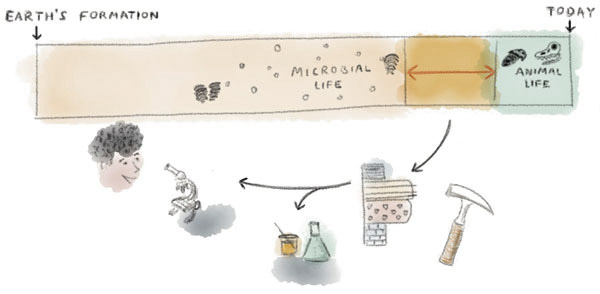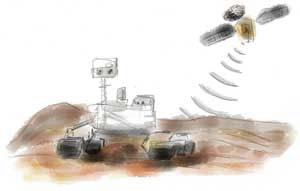
The MIT NASA Astrobiology Team
Foundations of Complex Life is a research project investigating the early evolution and preservation of complex life on Earth. Our team is funded by the NASA Astrobiology Institute at headquartered at MIT, but includes scientists at institutions across the United States.
About Our Research
Astrobiology is an interdisciplinary endeavor, and the scientists on our team use several approaches to study how complex life arose on Earth, and how its signatures are preserved:
1. By studying the genetic information in modern organisms to understand how complexity evolved in the earliest animals, and to better understand how we can use genetic information to tell when evolutionary events happened;
2. By studying the record of Earth’s history contained in sedimentary rocks from the time just prior to the rise of animals, between 1200 and 650 million years ago, reading these rocks for clues about changing environmental conditions by chemical analysis, and systematically scouring them for traces of life — from fossils as well as chemical signatures;
3. By making mathematical models of the carbon cycle in order to understand how oxygen — critical for large, complex organisms — was able to build up in the atmosphere because of changes in how organic matter decays;
4. By applying insights from studying the foundations and preservation of complex life on Earth to missions on Mars (members of our team are actively involved in mission planning for both the Curiosity and Opportunity rovers, as well as conducting laboratory experiments on Earth to enable interpretation of the data returned from Mars);
5. And, finally, by engaging the public in our research through an active program of education and public outreach, including teacher-scientist workshops, science festivals, museum collaborations, and interactive, multimedia online learning experiences.
Technical Summary
This project, selected as part of the NASA Astrobiology Institute’s CAN-6 funding cycle and centered at MIT, focuses on taphonomy—the combination of processes and conditions that preserve biological signatures. Over the past five years, our team has gathered a wealth of data about life and the Earth’s environment during the interval from 800 to 542 million years ago, when complex life evolved. This effort highlighted how little is known about what came before that interval, leading us to focus in this project on the state of the Earth between about 1200 to 700 million years ago, the late Mesoproterozoic and Neoproterozoic.
We seek insight into the early evolution and preservation of complex life by refining our ability to identify evidence of environmental and biological change in the the late Mesoproterozoic to Neoproterozoic eras. Better understanding how signatures of life and environment are preserved will guide how and where to look for evidence for life elsewhere in the universe—directly supporting the Curiosity mission on Mars and helping set strategic goals for future explorations of solar system and studies of the early Earth.
Questions we seek to address include:
- How are genomic and morphological complexity related? What caused the large Neoproterozoic perturbations of the carbon cycle, and how do they relate to the emergence of biological complexity?
- What determines the preservation of organic matter and fossils?
- How can the taphonomy of biosignatures in Meso- and Neoproterozoic rocks inform the search for life at Gale Crater on Mars?
Our team pursues these questions under five themes:
- The earliest history of animals. We use methods from molecular biology, experimental taphonomy, and paleontology to explore what caused the early divergence of animals and what underlies their long missing history in the Cryogenian and Ediacaran.
- Paleontology, sedimentology, and geochemistry. We will track the origin of complex protists and animals from their biologically simple origins by documenting the stratigraphy, isotopic records, and microfossil assemblages of well-preserved rock successions from 1200 to 650 million years ago.
- A preservation-induced oxygen tipping point. We investigate how changes in the preservation of organic carbon may have driven the Neoproterozoic oxygenation of the oceans coincident with the appearance of complex life.
- Taphonomy and Curiosity. As the Mars rover Curiosity explores Gale Crater, a site chosen in large part because of taphonomy, we will integrate research on Mars and Earth to understand martian environments and geochemistry.
- Synthesis. We seek to generate an expanded view of major transitions on Earth, environmental and biological, and apply this to develop a synthesis of the history of biological habitability on Mars.






